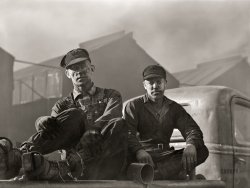
MAY CONTAIN NUTS

Search Shorpy
SHORPY ART

Framed or unframed, desk size to sofa size, printed by us in Arizona and Alabama since 2007. Explore now.
Join and Share
Ad-Free Shorpy
Shorpy is funded by you. Patreon contributors get an ad-free experience.
Learn more.

Recent comments
- Baldwin 62303
- Baldwin VO-1000
- Cold
- No expense spared
- Tough Guys
- Lost in Toyland
- And without gloves
- If I were a blindfolded time traveler
- Smoke Consumer Also Cooks
- Oh that stove!
- Possibly still there?
- What?!?
- $100 Reward
- Freeze Frame
- Texas Flyer wanted
- Just a Year Too Soon
- WWII -- Replacing men with women at the railroad crossing.
- Yes, Icing
- You kids drive me nuts!
- NOT An Easy Job
- I wonder
- Just add window boxes
- Icing Platform?
- Indiana Harbor Belt abides
- Freezing haze
- Corrections (for those who care)
- C&NW at Nelson
- Fallen Flags
- A dangerous job made worse
- Water Stop
Member Photos
The Shorpy
Print Emporium
Print Emporium
Search Shorpy
Search results -- 30 results per page
- Hotel Wisdom: 1942
- ... the carpet, and sanitize the remote.
Russell Lee and John Vachon Both Russell Lee and John Vachon spent a lot of time in the region in ... Posted by Dave - 11/03/2023 - 7:48pm -
![Hotel Wisdom: 1942 August 1942. "Big Hole Valley, Beaverhead County, Montana. Buildings on the main street of Wisdom, Montana, trading center for the Big Hole Valley. This is cattle country." Acetate negative by Russell Lee for the Office of War Information. View full size.
Battle Of The Big HoleAs American settlers moved west and justified westward expansion as the nation's Manifest Destiny, the Nez Perce had no alternative except to share their ancestral lands.
Eventually, Americans' interest in the land's riches and cultural conflicts between the settlers and the Nez Perce led to a series of bloody battles. One of the many battles, the Battle of the Big Hole in Wisdom, Montana changed the outcome of the Nez Perce War of 1877.
Montana: Big Hole National Battlefield
Last Saturday night ...Paul Bunyan decided to play horseshoes on Main Street and missed.
Rooms to let, 50 centsNo phone no food no pets ... Hotel Wisdom
Phone line Horse sneakers!
Hotel wisdomDon't walk barefoot on the carpet, and sanitize the remote.
Russell Lee and John VachonBoth Russell Lee and John Vachon spent a lot of time in the region in the late 1930s and early '40s. In fall 1942, perhaps they were traveling together, as both have images of Wisdom in the archive.
Quoting Mary Murphy (Montana State professor):
Vachon drove his Plymouth into Beaverhead County in the spring of 1942 with the assignment of photographing stock raising. After several days, he wrote to FSA Director Roy Stryker that he had found “the purest most undiluted West I've ever seen.” (Source: her presentation)
Another interesting tidbit about how Vachon described his drives through the county:
From Butte, Montana, in March 1942 he wrote [to his wife Penny] of “regretting a very abject and cowardly performance about 3:00 this afternoon.” Vachon is reproaching himself for fearing to drive the road from Wise River to Wisdom, which is “one lane bumpy full of puddles holes heavy snow and cliff hanging.” It really rankles when the attendant at the Wise River gas station tells him, 'The mail stage makes it every day'.” (Source: Big Sky Journal)
LIQWhen the boys leave the bar with snootful, it's forgotten that what goes up must come down. And the nearest hospital is (probably at least) 50 miles away.
Measure twice.The carpenter placed the hotel windows symmetrically. The sign painter missed.
Wisdom = Having InsuranceIt seems almost unnecessary to ask, doesn't it? (05/21/60)
Despite what might seem like daunting odds, Fetty's rebuilt, and seems to still be in business. The hotel, however, seems to have checked out.
A tossupWhat's with the horseshoe up on the power lines?
The town that Coke forgotThere's a Chesterfield's ad at the liquor store (the largest of the four buildings shown); but I do not see a Drink Coca-Cola sign, usually a standard feature in 1940s main street photos.
The distances to the nearest towns in either direction reminds me of the saying -- it's not the end of the world ... but you can see it from there.
At some point that horseshoe is going to be an UN-lucky horseshoe for someone.
Lean on me1939 Chevrolet Master Deluxe 4-Door Sedan.
Makes me wonder how many times the Chevy completed
the aforementioned fearsome trek from Wise River to Wisdom.
(The Gallery, Russell Lee, Small Towns, Stores & Markets)](https://www.shorpy.com/files/images/SHORPY-8d08251a.thumbnail.jpg)
- Track Shacks: 1941
- ... in Norfolk, Virginia." Medium format acetate negative by John Vachon for the Farm Security Administration. View full size.
Objects ... Posted by Dave - 02/22/2021 - 8:47pm -
![Track Shacks: 1941 March 1941. "Overcrowded Navy towns -- housing in Norfolk, Virginia." Medium format acetate negative by John Vachon for the Farm Security Administration. View full size.
Objects along the trackFrom the close-up, I suspect not a cable or conduit, but a rigid push-pull rod to the semaphore. Simple mechanical interfaces worked well!
John VachonAn informative and interesting article about Mr. Vachon from American Heritage magazine, February 1989.
https://www.americanheritage.com/john-vachon-certain-look
This image has me wonderingFirst, I wonder what those things along the edge of the track roadbed are. I don't recall ever seeing anything like those before.
Second, it appears one of these shacks has a garden area behind it, rather than privies and sheds. I wonder if the privies were remnants of an earlier time and the shacks had indoor plumbing in 1941. I also wonder if tenants in the shacks with clutter behind them paid less rent than the one who could look out on the garden.
What's all this then? Can the items behind the homes, near the tracks be torches to designate the fact there's a curve? Or for some other reason, there's around 20 of them that continue until the photo goes out of frame.
Shanty shenanigansI see wide open (if perhaps squalid) rural living! Maybe this little shanty trio is the result of overcrowding elsewhere. Or maybe there are 10 families living here. Or maybe the title comes from a series of photos containing other more representative examples.
Whatever the case, for me this photo begs two far more important questions:
What is the vantage point from which it was taken? It resembles a modern drone shot. I know that balloons were used in this era, but that seems like an unlikely effort to put forth for a shot like this.
Secondly, and most importantly, is the kid beating the man about the face with a rusty bucket on a stick?
Rodding and cableThe iron chairs next to the track are carrying two control functions. The thick "rodding" is iron pipe rigid enough to provide push-pull control against stiff mechanical resistance. It is supported both top and bottom by concave rollers in the chair castings. Behind the outhouses (the picture below) is a pair of bell cranks that compensate for thermal expansion, converting "pull" into "push" and vice versa. They are located precisely at the center of the pipe run.
Near the signal, the pipe rodding changes direction via a bell crank to operate a derail, to enforce a stop indication before a train plows through the track crossing at the junction ahead, or more likely another junction behind the camera. By US convention, the nearer semaphore is facing away, controlling movements toward the camera, and the further white mast signal controls movements toward the crossing. ie, signals were located on the engineer's side.
The chairs and bell cranks are mounted on heavy concrete blocks that extend well below the ground surface for rigidity.
Somewhere behind and to the right of the camera is a manned "armstrong" signal tower that operates the derail and semaphore via very large levers. Probably another junction or passing siding. The photographer may have climbed a signal mast guarding the nearer junction.
Next to the pipe is a thin tension cable that operates the semaphore, similar to European practice.
As a teenager, I used to hang out at an armstrong tower in our town, and have one of the support rollers from when it was torn down.
Vachon's preparedness assignmentThe recent spate of John Vachon's photos from 1940 and 1941, relating to military and similar construction and environments, points to something little-realized today: American involvement in World War II did not start with Pearl Harbor. Increasingly through the two years, the Roosevelt administration pushed preparedness, and did what it could to aid Britain and others fighting the Nazis. All against strenuous opposition from America-first isolationists. (Sympathizers with that movement included not just Charles Lindbergh but John F. Kennedy and Gerald Ford.)
Vachon was still working for the Farm Security Administration in 1941, and it would be interesting to know more about the background of this large-scale assignment documenting people and places being transformed by preparedness.
Poor Side of TownFrom the view of the overall picture this is the wrong side of the tracks. The trip to outhouse was an adventure in the making.
Umm what?Is this a man with a bucket for a face attacking children?
Obstacle courseMidnight trips to the privy must have been a challenge.
Of course they may have kept a 'thunder mug' (as my grandpa called it) in the house so going out wasn't necessary.
Objects along the trackWhat are the objects spaced along the near edge of the tracks? I'm sure that when someone answers the question I will say "Well duh, of course" or a sarcastic "I knew that".
[It's a cable or conduit leading to the semaphore on the curve. - Dave]
A bad guessWithout the date & photographer identified in the caption, I might have guessed: Mathew Brady, 1861. If I knew what the gizmos along the track were, and their history, I may have made a better estimate.
I think it is a control for a switch or a signal. Railroads in times past used a rod set on rollers or bearings (as shown here) with a push-rod and a pull-rod to move the signal indications. This was controlled by a lever in a signal tower by a "lever-man".
I'm with bobstothfang "Well duh, of course", "I knew that".
Objects along trackbobstothfang asked about the above. This is not a cable or conduit, exactly, but a pipeline - that is, a pipe which mechanically operated the signal just this side of the grade crossing. In this instance, it also operated a derail (a device to intentionally derail a train). If the signal were at "Stop" (as seen in the photo), the derail would cause a train passing the signal to come off the track before it could cause an accident (probably a more serious accident) out of the picture to the right.
Rods from Tower . . .The objects being discussed appear to be a control rod and supports that run to a flop derail and signal governing it. There seems to be another crossing and tower in the distance, but this rod must run to a tower behind and to the right of the photographer. The attached photo has a more complex arrangement that controls several switches, etc.
What's at the other end of the rods --can be seen here.
(The Gallery, John Vachon, Norfolk, Railroads)](https://www.shorpy.com/files/images/SHORPY-8c19027a.thumbnail.jpg)
- Standard Service: 1940
- ... Dubuque, Iowa." Medium format acetate negative by John Vachon for the Resettlement Administration. View full size.
Hairy Cat ... Posted by Dave - 11/14/2019 - 11:35am -
![Standard Service: 1940 April 1940. "Gas station on a sunny afternoon. Dubuque, Iowa." Medium format acetate negative by John Vachon for the Resettlement Administration. View full size.
Hairy CatConsidering the Cat's hair in this self-portrait (https://www.shorpy.com/node/25187), I wonder if Mr. Vachon was peering over the camera and looking at the lens (or out the window) the moment this exposure happened.
[He was looking down into the viewfinder. - Dave]
That does double for me!I loved all my twin-lens reflex cameras and wish I had kept them. But nnnnoooooo ...
Current view?The Page Hotel, located in the upper left, was located at the corner of Fourth and White streets. This view from Google Maps, appears to show approximately the same view. Not sure if the existing brick building across the tracks is the same one in the current view.
U.S. 61 Freeway There NowBased on this article, the Page Hotel stood at Fourth and White Streets, about where the U.S. 61 freeway is now.
http://www.encyclopediadubuque.org/index.php?title=PAGE,_John
Heavy metalBeing a steam locomotive fanatic, I would want a room facing the tracks in the hotel. Unfortunately I wouldn't be born until Nov. of 1940. Looks like a busy crossing and with the baggage carts must be right at the depot.
John VachonJohn Vachon's FSA pictures are sadly underrated. He was highly influenced by Walker Evans, whose plain and unpretentious portraits showed little evidence of advocacy or drama. Vachon had the same style, but his subject matter often differed from that of Evans. Vachon was young and inexperienced when he was hired by FSA head Roy Stryker. He fell in love with the camera, and loved touring the country for the first time. He photographed just about everything he saw, in this case a gas station near the railroad tracks. Consequently, his vast collection of pictures has become a valuable document of how life and the built environment looked in the 1930s.
If you build it they will comeIt's kind of hard to see but if you follow the road (4th Street) from the bottom towards the top of the picture you will see a baseball stadium in the distance. It was known alternatively as Municipal Stadium, 4th Street Stadium, or John Petrakis Park. It was built in 1915 and was razed sometime in the 1970s, I believe. It hosted several minor league ballclubs.
Double visionUnlike commenter Jim Page, I'm a newcomer to twin-lens reflex cameras, having started to collect them last year. I found this image of Jack Delano somewhere in cyberspace. I believe that's a Zeiss Ikon Ikoflex around his neck. Being a serious fan, I just had had to buy one.
Gas PricesWhat's up with the sign? Prices? Octanes?
[Yes. - Dave]
Photographer's viewpointWell, we can see where the photo was taken from in radiochris's modern shot.
There was a fire here, tooThe six-story brick building shown in the "Current View" post is the Canfield Hotel, built in 1927 as an addition to the existing four-story wooden structure. In 1946 a fire destroyed the older wooden building, killing 19 people, including owner William Canfield. The picture would have been taken from the four-story wooden part. An account of the fire:
http://www.encyclopediadubuque.org/index.php?title=CANFIELD_HOTEL
(The Gallery, Cars, Trucks, Buses, Gas Stations, John Vachon, Railroads)](https://www.shorpy.com/files/images/SHORPY-8c16972a.thumbnail.jpg)
- Zell Hall: 1942
- ... Dakota. Community hall." Medium format acetate negative by John Vachon for the Office of War Information. View full size.
Step on Up ... Posted by Dave - 10/19/2021 - 2:37pm -
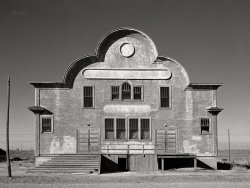
- Slum Kids: 1940
- ... "Children who live in the slums." 35mm nitrate negative by John Vachon for the Farm Security Administration. View full size.
Dumbstruck ... Posted by Dave - 09/01/2010 - 3:04am -
![Slum Kids: 1940 April 1940. Dubuque, Iowa. "Children who live in the slums." 35mm nitrate negative by John Vachon for the Farm Security Administration. View full size.
DumbstruckI made the dumb mistake of looking at it full view. What a haunting photo.
Learn something new every dayI didn't know that little Sandy Duncan grew up in Dubuque.
What are they doing now?They do look a bit sad ... I wonder what they did of their lives, and what they are up to now. They must be about 65 years old now.
[They'd be at least 75. - Dave]
Haunting meFor some reason their face expressions haunt me after studying them for about 20 or more minutes. I am approaching 70 years on this planet now and even after all those years my heart can and does go out to them. My hope is that first comment "Entitlement- - " came true for them. They look like they deserve it.
Poor kidsNice patch job on the boy's pants. Even though they are quite young they understand the meaning of poverty. It is etched upon their faces.
Tugs at the HeartSomething about this photo makes me want to grab and hug them, and tell them everything is going to be alright.
HeartbreakingI don't have any other words. This picture really affected me. There is no excuse for the suffering of children. The clothes, the girl's eye, the dirt. I wonder what became of these kids. What life did they lead.
EyesThe girl has "lazy eye"? Easily corrected in the young, but not in adults, according to the Net.
Doh!I love Shorpy and view it every day in the hope and anticipation that I'll get to see some old school photos of my lovely home town. Maybe of the tragically destroyed Union Park, or our historic and recently renovated Shot Tower, or even the downtown bustling with shoppers and beautiful architecture. Oh well, I guess I'll have to make due with a couple of sad slum kids. :D
Growing up poorWhen you grow up poor, there is nothing anyone can do to you that life itself hasn't already done. Trust me.
HeartacheAren't they precious? I want to scoop them up and hug them. Oh, how I hope they went on to have long, happy, bountiful lives.
Inspiration They look like the inspiration for those "Sad-Eyed Kids" paintings.
The thing about kidsis that unless someone TELLS them they are deprived and that their lives are terrible, they often don't live their lives that way.
I'm not trying to romanticize the life of the poor but as long as they are loved and can play and enjoy their friends, they are usually perfectly happy. The minute they are treated as "different," that other people should look down on them, that they aren't equal to their friends, that's when they learn to hate themselves.
No entitlement mentality here!They were born in the mid-30's and are poor here, but they will be part of the small generation of young adults in the mid-1950's and enjoy America's great Postwar economic boom. They'll get a good education in the schools of the day, most likely better than those of today, and be able to get employment for life. Life after World War II will just get better and better for them and compensate for their poverty as children. They're in their 70's now and I hope comfortably retired with lots of grandchildren and great-grandchildren who love them.
John VachonI had never known about Vachon's photographs until seeing them on Shorpy, but I am starting to believe he's one of the great photographers of his generation. It's incredible that he had no art, design or photography training before starting with the FSA as a filing clerk and messenger. It's easy to see why Roy Stryker said Vachon was the FSA's "congenital photographer." He had amazing and innate talent and artistic insight, as this image clearly shows.
[He also took a bazillion pictures. Quite a few of this pair, shown below in happier times. Like 30 seconds later. - Dave]
What happened to them? Victrolajazz is right about the opportunities these kids had as they got older. For better or worse, however, their early upbringing was probably never forgotten. My aunt, slightly older than these two, carried the memories of poverty in the Depression all of her life. Even as a well-to-do senior citizen she would always buy the winter coat that cost less, no matter what she preferred. I sometimes think that that feeling of "the wolf at the door" was a better one for our country.
Depression BabiesA friend and I were born in 1930. He thinks the 1930s were the best time for this country. As I recall the decade, life was good for those who had jobs. The father of a boyhood friend was a handyman at the streetcar hq. Over time he made enough to buy a new house and a new car. He took the family every summer on a long trip. His wife did not work. They were frugal. They went to church about three times per week. The church actually was just a basement, the rest unfinished. The 1930s featured a lot of unfinished buildings. Scientific studies show that church is good for people in many ways.
Geez, what's wrong with a little dirt?They've already proven that letting kids get dirty gives them a little resistance to things like polio and asthma.
Except for the lazy eye, I could have sat right next to those kids at that age and fit into the pictures. Those kids ran and jumped and played all day. They did not sit in a room holding a little box staring at it all day. They caught bugs, made swords and knives with sticks and the little boy probably dropped a frog down his sister's back a time or two.
I feel sorrier for kids today than I do for these beautifully shaped kids.
It's not that her left eye is lazy,It's that her right eye is an overachiever!
John VachonJohn Vachon was, in my opinion, the best of all the FSA photographers. His pictures lack the sometimes self-conscious drama of Dorothea Lange. They are plain, less artful, and often concentrate on the landscapes of towns and cities, instead of people. For that reason, his work is perhaps the most valuable collection we have of what the uncelebrated and unnoticed parts of America looked like during this era.
OK, Dave, now you've done itAfter looking at hundreds of Depression era photos here and elsewhere, I thought I had seen the most poignant, precious faces there could be. But when you posted the smiling photo below, these little beauties took on a dimension far beyond what two photos should be able to create. Despite their obvious poverty, they radiate in their innocence a joy that I desperately hope they were able to find again for keeps, as they went through life.
BeautifulSuch a beauty in such a cruel world. A thank you to the person who posted the second picture. That smile is so familiar. Timeless.
(The Gallery, John Vachon, Kids)](https://www.shorpy.com/files/images/8a05450a.thumbnail.jpg)
- A Place in the Sun: 1939
- ... Another shot of someone who may or may not be Penny Vachon, perusing the February 1939 issue of Fortune. Photo by John Vachon. View full size.
Rob Lowe's Grandmother?
John ... Posted by Dave - 11/26/2011 - 3:04pm -
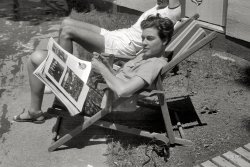
- Etna: 1941
- ... Etna, Pennsylvania." Medium format acetate negative by John Vachon for the Farm Security Administration. View full size.
No Known ... Posted by Dave - 09/06/2020 - 2:23pm -
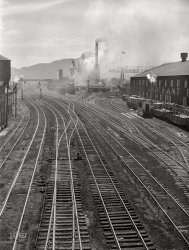
- Coeducated: 1942
- ... in their apartment." Medium format acetate negative by John Vachon for the Office of War Information. View full size.
Nice leg ... Posted by Dave - 03/27/2021 - 1:03pm -
![Coeducated: 1942 May 1942. Lincoln, Nebraska. "University of Nebraska during final exam and commencement week. Bob Aden studying with his wife in their apartment." Medium format acetate negative by John Vachon for the Office of War Information. View full size.
Nice leg makeupShe either bought the premium stuff or really had a good tan; silk stockings were NG by that time. Needed for the war effort.
A better captionI don't know what this says about me, but my first thought for a new caption was "Bob Aden mansplaining the concept of in-group dynamics to his wife, Marion. Both are students at University of Nebraska." (I'm pretty sure that's a social psychology textbook.)
Keeping track of John VachonOver past months on Shorpy, we've been following John Vachon as he moved around photographing military preparations and military environments during the lead-up to U.S. entry into World War II. Now the war is on and Vachon is assigned to the Office of War Information. Here he is in the farm belt, photographing university students, one an MBA candidate, the other a liberal-arts major. The connection to War Information? The Adens' lives, like almost everyone's, are about to change radically.
Looking forward to following Vachon's further movements. (He stayed with OWI until it was shut down in 1943. He was drafted near the end of the war.)
Apologies to Dali, a melting radio?Being a native Floridian my experience with radiators is minimal but I'm told they can get really hot.
A few observationsIt must have been a nice day with the window cracked. Bob's shoes need a shine (the Navy will fix that) but otherwise the happy couple seem to be fairly comfortable. I note their own telephone which was a luxury not within the budget of your typical college students. Even a party line hookup cost more money than most students could afford. I am guessing that come graduation Bob will be off to the Navy per a comment on the previous discussion thread.
Those Old PhonesCould weigh a ton. My grandmother had one (from the 30's) and holding that handset for longer than a few minutes would give her cramps. They were not all that good at fidelity either.
Leg Makeup Did Exist.I was an urchin during WWII. My aunts did buy leg makeup in a bottle that to my untrained eye did look like the real thing.
That sofa!My great aunt had a sofa with upholstery like that, and it's very unusual. The pile is almost wiry, yet you could push it from side to side with your hand. Strangest feeling upholstery ever.
[It may have been some sort of scrunchy nylon. My grandparents had a swivel chair upholstered with the same stuff. - Dave]
Domestic dreamyI'm crushing on the understated romance in this photo, since I'm sure Mr. Aden was covertly admiring Mrs. Aden's gorgeous gams, leg makeup or no leg makeup. (And I LOVE leg makeup ... I'm wearing Sally Hansen Airbrush Legs as we speak.) Another thing I love is Mrs. Aden's cute glass shelf and the charming little lay-abouts placed just so both there and on the sill beneath. And I want that Bakelite radio.
Family CircusThe Family Circus comic book just peeking out in the magazine holder is perfect. I'm sure these adorable co-eds weren't reading it. Leaves me wondering, who was the Family Circus fan?
[Comic book? - Dave]
I stand corrected ... never heard of Family Circle mag, though Wikipedia says it continued to be published until 2019.
(The Gallery, Education, Schools, John Vachon)](https://www.shorpy.com/files/images/SHORPY-8d04867u.thumbnail.jpg)
- Lonesome Highway: 1942
- ... Panhandle highway." Medium format acetate negative by John Vachon for the Office of War Information. View full size.
Erastus Smith ... Posted by Dave - 03/02/2024 - 11:53am -
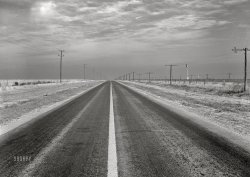
- Fast Food: 1938
- ... in Nebraska, October 1938. 35mm nitrate negative by John Vachon for the Resettlement Administration. View full size.
The days ... Posted by Dave - 09/09/2010 - 11:43am -
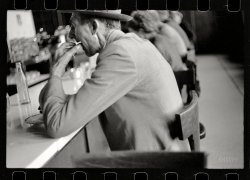
- Traffic-Stopper: 1941
- ... just a block ago, they were strangers. 35mm negative by John Vachon, who has a lens for the ladies. View full size.
I saw you, John ... Posted by Dave - 02/17/2013 - 11:22am -
![Traffic-Stopper: 1941 "Michigan Avenue, Chicago, July 1941." And just a block ago, they were strangers. 35mm negative by John Vachon, who has a lens for the ladies. View full size.
I saw you, John VachonEnlarge the picture and you'll notice her discreet but smiling gaze toward the photographer. And suddenly the man is more real to us. What a lovely girl.
Strangely FamiliarGood Lord, I think it's Dairy Queen's big sister!
Faux Purse?A handsome couple and a gorgeous girl but what is that she is carrying? Surly not a purse. A train case perhaps?
[He's definitely not a purse, but the jury is out on surly. -Dave]
Just maybeThat's a cosmetic case in her left hand, needed for an overnite stop at the "Hotel Discreet" just up the street.
[Or it could be a camera. -Dave]
The Lucky guyand lovely woman seem to be walking northward, north of the river, given what appears to be a downward slope to the street from right to left---towards Chicago Avenue. If so, they’ve just crossed the overpass (marked by the billboards) of the street that took one eastward to the Chez Paree. Have walked the mile many times in the late 50s while going to school in Chicago, frequently in the company of Miss Mickey. (Mickey, I still adore you, wherever you are.) Christopher Lasch once observed that fond memories will be a source of sustenance in old age. Truer words have never been written or uttered. And oh, my warmest regards to the ubiquitous Checker A.
The classy looking car at left?Although out of focus, it's a 1941 Buick.
Surviving buildingsThe couple is indeed crossing Ontario Street, walking north. On the other side of the street, at 601 N. Michigan, is a four-story building that first housed the Lake Shore Trust & Savings Bank, then the First National Bank of Chicago, and now a Chase branch surrounded by a Guess clothing store. At the time of this photo, its classical features (rounded columns) were understated. Further down that side of the street (across Ohio), behind the "RCA Victor" sign, is the Jacques Building, 543-545 N. Michigan. It was built in 1929, has art deco features on its facade, and is topped by a Paris-style mansard roof. After recently housing a Nokia store, it is currently undergoing a mildly controversial renovation.
Even today.....that young lady would stop traffic.
Three buildings in the photo still existOn the far right edge of the Shorpy photo is a sliver of the Chicago Tribune tower.
Next to the Trib is the former Medinah Athletic Club (now the InterContinental Hotel).
545 N Michigan Ave has the RCA Victor sign in the Shorpy photo. It's a Nokia store in the current Google street view.
View Larger Map
No traffic?Gas rationing is a year away but there are only three cars visible. Doesn't that seem strange?
Avon calling!Perhaps she is an Avon lady. I'd buy something from her.
And him for that matter.
Could he be blind?I believe this man could be blind, as the eyes appear quite sunken or he is squinting. But why squint? The woman isn't.
Doc?If he was carrying a guitar case, I'd swear that was Doc Watson escorting the lovely lady.
Re: Faux PurseThe young lady is carrying a train case. My mother had one exactly like it. It was dark blue "alligator" with a brown leather handle. It had a removable tray inside. With it was a plastic two-piece box for bar soap, a shoe horn, a button hook for shoes or a dress with small buttons and a comb. The exterior of the case deteriorated years ago and it was discarded. I don't know what happened to the soap box and comb, but I still have the shoe horn. I had the button hook until a few years ago when the plastic handle deteriorated and the metal hook rusted, so I threw it out. The plastic items were made of a grayish mother of pearl finish over a brown plastic. Very stylish. And as a kid, I used to like to open the latch to the case. When you would close it, it made a very secure sounding "pop".
Doc!Oh my! I think jimchig has it nailed. I pulled up two windows of the photos to the same scale size and I think this is indeed Doc Watson being guided down the street as lulu states. RIP Doc, your performances will be missed.
[Below, left: Doc Watson in 1939 at age 16. - tterrace]
Guild for the Blind?Though she is doing a very good job of not making it obvious, it appears the gentleman is being guided at the elbow by the woman. With The Catholic Guild for the Blind (now called Second Sense) about 1/2 mile from the location noted below, I think Mr. Adams may be correct that the man in the photo may be blind.
Not DocThe similarity is striking, but Doc never left western NC/eastern TN until "discovered" by Ralph Rinzler in 1960.
(The Gallery, Chicago, John Vachon)](https://www.shorpy.com/files/images/SHORPY_8a33113a1.thumbnail.jpg)
- Pittsburgh: 1941
- ... Pennsylvania." Medium format acetate negative by John Vachon for the Farm Security Administration. View full size.
I love the ... Posted by Dave - 01/17/2023 - 2:46pm -
![Pittsburgh: 1941 June 1941. "Rain. Pittsburgh, Pennsylvania." Medium format acetate negative by John Vachon for the Farm Security Administration. View full size.
I love the rain...This photo immediately brings forth the smell of rain, the hiss of car tires as they pass and the drip drip drip of rainwater off the eaves of the porch.
Pittsburgh by VachonThis is a beautiful picture. John Vachon's photos did not have the pathos and personal drama of Dorothea Lange's work, but more than any other American photographer, he has left an invaluable scrapbook of the vernacular American landscape. He is my favorite photographer.
What are the towers ...... in the background? Is that another church? Looks Orthodox. Perhaps someone familiar with Pittsburgh will know.
A Rainy DayThe person walking with the umbrella really makes the photograph work. You can almost feel the rain..
Pittsburgh PrecipitationI agree with others here about the evocative quality of this photo. Staring at this for a few moments I swear I can hear the rain coming down!
Canada Dry SpurCanada Dry Spur ("the cola drink with Canada Dry quality") was Canada Dry's attempt at entering the cola wars. By this time of course the company was owned by P.D. Saylor and Associates and the only connection with Canada was the name.
Such a wonderIt's 103 degrees on my front porch (yes, that's in the shade), my part of Arizona hasn't seen rain in 3 or 4 months. Guess whats going on my desktop. Thanks.
DSS
Look how it falls straight down!Not only can I relate to DSS since we don't get a lot of rain in West Texas, but I'm just amazed at how it's coming *straight down*. (Huge gusts of wind aren't sucking her umbrella inside out, and the rain isn't coming in sideways and raising welts on her skin!)
P.S. Not that I'm complaining...I love it here, and my glasses usually protect my eyes from the infrequent SIDEWAYS rainstorms!
Tioga Street, PittsburghPittsburgh has a lot of onion-dome ethnic churches all over town. The 1941 City Directory lists a Wm. James Confectionery at 7314 Tioga Street, which is where Point Breeze meets Homewood meets nothing original still standing. This would be east of downtown.
South Side P-BurgThis looks like the "South Side" of Pittsburgh and if I am not mistaken, this is an orthodox church which is now the private home and studio of the owner of the number one Pittsburgh chain of hair salons and spas.
Morrow TriangleAtlantic ave is a one-way northward running street to the east of downtown. The only intersection that makes a bend like the one photographed is at Liberty and Baum. There are no row homes or churches there now though.
The vantage point of the photo is a parklet called Morrow Triangle. The filling station and church are now the site of a car dealer. Unless there was a street name change that the Atlantic ave in the picture is different from the current Atlantic ave I think I'm right.
[The "Atlantic" sign is advertising a brand of gasoline. - Dave]
It's SouthsideI've lived in Pittsburgh all my life and this shot looks remarkably like the Southside (flats) to me just off Carson Street. Many churches of similar Greek Orthodox venue there. A previous poster indicated he thought that Atlantic sign was a street. It looks like a gas station to me, or something else.
It's DeutschtownThis is the corner of Madison and Lockhart, looking west. The church with the onion domes is St. Mary's -- Bavarian Catholic, believe it or not.
You can't go and see this intersection anymore since it was destroyed in the 1980s so that the Parkway North could be built. The church is still there, although now it's a hotel.
Pressley StreetThe previous comment is correct. That's St. Mary's (now known as the Priory) which sits at 614 Pressley Street.
Atlantic GasThe Atlantic sign is for the gas station. Atlantic petroleum was founded in Philly, then eventually acquired by Sunoco in the 80's or 90's.
(The Gallery, John Vachon, Pittsburgh)](https://www.shorpy.com/files/images/SHORPY-8c19363a.thumbnail.jpg)
- TICKETS: 1943
- ... waiting room in the railroad station." Acetate negative by John Vachon for the Office of War Information. View full size.
$100 Reward ... Posted by Dave - 04/19/2024 - 6:37pm -
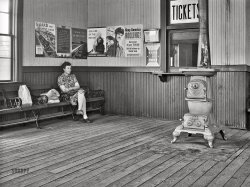
- The Woman in the Window: 1943
- ... for railroad crossing." Medium format acetate negative by John Vachon for the Office of War Information. View full size.
Just add ... Posted by Dave - 04/16/2024 - 11:25pm -
![The Woman in the Window: 1943 May 1943. "Beaumont, Texas. Wartime occupational replacement by women in men's traditional jobs. Lady in signal tower who operates block signals for railroad crossing." Medium format acetate negative by John Vachon for the Office of War Information. View full size.
Just add window boxesTwo fallen flags --
MEC Maine Central: The Pine Tree Route
T&NO Texas & New Orleans: a subsidiary of the Southern Pacific Railroad
Whether it's a tower to control trains or highway gates, it is well-built, airy, and in need of some flower boxes to complement this sturdy structure
I wonderif the lady managed to get his attention. He seems to be engrossed on his phone?
NOT An Easy JobThis is not an easy job.
In my young days before I came to the USA, I was a conductor Guard on British Railways (as it was known then). Part of the training was to observe the signalman in the signal box (as they were called back then), and to see how that job functioned.
The strength needed to pull those levers was tantamount to doing the job correctly.
Kudos to that lady for doing that job.
You kids drive me nuts!She's clearly yelling at the brakeman to stay off his dang smartphone while he's working
WWII -- Replacing men with women at the railroad crossing.Postwar world -- Replacing both with automatic machinery.
Just a Year Too SoonThe film noir "Woman in the Window" premiered in 1944 with an innocent Clark Kent-like Edward G. Robinson becoming involved with a beguiling woman and a murder.
Texas Flyer wantedIs there a a ladder hidden behind the signal box, or is that what we're seeing on the leg in the foreground? (If so, it looks rather difficult to climb). But regardless, this appears to be a position where getting to work is the hardest part.
[There's also a ladder on top of the signal box. - Dave]
Indeed, but I believe she'd have a hard time reaching it.
(The Gallery, John Vachon, Railroads, WW2)](https://www.shorpy.com/files/images/SHORPY-8d19830a.thumbnail.jpg)
- Ebby's Diner: 1942
- ... the Corine Hotel at Queen and Chestnut streets. Photo by John Vachon for the Office of War Information. View full size.
Trolley 236 ... Posted by Dave - 02/25/2024 - 3:47pm -
![Ebby's Diner: 1942 February 1942. "Lancaster, Pennsylvania." Ebby's Diner and the Corine Hotel at Queen and Chestnut streets. Photo by John Vachon for the Office of War Information. View full size.
Trolley 236 still runningLancaster had a city streetcar system and an extensive electric interurban railway service in the area. It lasted until 1947 when buses replaced the trolleys. Birney car 236 still runs in nearby Manheim, and you can learn all about it in this video. John Vachon's street views from above really capture that moment in time.
Delicious geometriesCertain photos on this website work their magic immediately and then leave me to try to figure out where the power comes from. First to spring out at me are the pleasing geometric planes, forming a big Z in the middle, with the streetcar tracks acting as the central diagonal. Then there’s Ebby’s Diner, which appears like a larger version of those two streetcars. And the allure of those cozy establishments -– how I wish I could go to eat at that diner or The Village restaurant or even Sprenger’s, whatever kind of place that is. And winter! Bravo, John Vachon.
Here and GoneThe diner is gone. It would have been to the far right facing Chestnut. The hotel is gone too. It would have been where the parking lot is now. The three-story brick building remains with some modifications. The commercial ground-floor space was removed.
Great photo!What a great photo!
WowEchoing @davidK, this photograph is a masterpiece.
Whazzat?Is that a lumberyard in the upper right? It’s an unusual open-sided structure
The Old PRR Main LineThe original Pennsylvania Railroad main line passed through Lancaster right through the downtown area. The depot was located at Queen and Chestnut Streets. You can see a boxcar under the roof where the original depot once stood. Apparently by this time the track had been terminated here and that boxcar is now sitting in what would probably be a covered team track. A study of satellite views will reveal parts of the old right-of-way and some buildings cropped at odd angles or others that were once parallel to the tracks.
[update]
Upon finding maps of Lancaster circa 1900 I have concluded that the actual PRR trackage passed right across the lower portion of the photograph frame and, indeed, Ebby's Diner is perched directly on the former right-of-way. The box car further down E. Queen St. is actually on a stub-end siding that once served a business there or could have been a freight house.
Ebby's Was The Old Pennsy RR StationI could be turned around, but I think the view faces northwest, in which case the train station was on the lot where Ebby's stands in this photo. The tracks came into Lancaster from the N.W. and crossed the empty lot next to (left of) the Hotel Corine, then across Queen Street to the passenger station. The beginning of these tracks are visible from Dillerville Road (or on Google Maps) near the western end of the Norfolk Southern Lancaster yard. The tracks crossed Harrisburg Avenue west of the new stadium and ran into the center of town. The boxcar under the shed was one of many stub tracks that branched into small sidings. Bits of the right of way were turned into parkland or create strange property lines that are still visible, as G of V noted. The tracks then continued east and north to rejoin the main line.
Also goneis the building from where John Vachon took this photograph. If you swing around in the Street View supplied by kozel, there's a Holiday Inn there now. No doubt it was a cold February day in Lancaster, yet two windows at the corner hotel (I can't read the name) are open. On the top floor one is open a little. The window directly below it is wide open. Brrrrrr.
This Photo Smells So GoodMy mouth is watering, what with the cooking smell coming from the diner and the cold frigid air that carries the smells of the bacon and eggs, or steak and potatoes to your olfactory senses.
The hotel might have a place to eat as well, if so, that would overload the senses with its waft of whatever is non the grill.
Another odor would be the scent of freshly laundered sheets and/or towels from the Laundry at the top left of the picture.
A-lone survivorBuilt like a brick shi... er, well, solid as a rock. Probably good for another coupla hundred years.
About those open windowsDoug (see below) pointed out that on an obviously chilly day, a couple of the windows in the hotel are open. Back in the day it was a routine practice for housekeeping to throw open windows in recently vacated rooms to air them out. This would have been especially desirable in an era when smoking was so common, even in hotel rooms. Also, most hotels did not have individual thermostats in rooms to control the heat. The heat was typically from radiators or from ventilation grates in the floor connected to an often coal fired furnace. In either case, the heat was usually controlled by the hotel staff. Sometimes rooms could get a bit stuffy or just plain hot, to the point where even on a nippy day, cracking a window for a few minutes might be the only way to get some fresh air and cool off.
Lancaster's Pennsy StationI found this early view of the Pennsylvania Railroad Station courtesy of the Lancaster County Historical Society.
Sometimes It May Not Have Smelled So GoodThe Lancaster Stockyards, the largest stockyard east of Chicago, was located about a mile north of here along the PRR mainline between Philadelphia and points west. It handled 10,000 cattle a day, along with pigs, sheep and other animals arriving by rail from the west. After a layover, the doomed animals boarded connecting trains and were distributed to other cities to meet their fates. If the wind was just right the scent of bacon and steak on the hoof may have tainted the wonderful odors emanating from Ebby’s and The Village.
142 units, 12 stories, $7,556 per mo.The site of the former Corine Hotel, shown as a parking lot on Google Street View, is currently a construction site for a market-rate rental development, scheduled to be finished by late spring 2024.
[$7556 is the rental rate for the first-floor retail/restaurant space. - Dave]
More Open WindowsI can definitely related to Ad Orientem's comments on heated hotel rooms.
To paraphrase Mark Twain, the hottest Summer I ever spent was a Winter's night in Moscow!
We spent several nights in Moscow's Hotel Ukraina back in January, 1998. Imagine sleeping in underwear, on top of the bed, with the floor-to-ceiling (unscreened!) windows open to try to catch a breath of breeze. Under 10F outside, and over 80F inside, with no way to regulate the steam heat!
The downside of free city-wide steam.
Closed?The diner shows no signs of life that I can see. Can anyone read the sign on the door?
[All those footprints would seem to indicate otherwise. - Dave]
Man in BlackExceptionally composed photograph. To my eye the man in black along the roadway is the focal point. The angles lead to him. I am always amazed by snow scenes, the intensity of reflected light, which even on a cloudy day usually requires a small aperture with attendant great depth of field and sharpness.
(The Gallery, Eateries & Bars, John Vachon, Streetcars)](https://www.shorpy.com/files/images/SHORPY-8d12447a.thumbnail.jpg)
- Yard Man: 1942
- ... again , somewhere in Grand Island, Nebraska, snapped by John Vachon for reasons unknown. Cinch up that tie and get back to work! View full ... Posted by Dave - 03/08/2022 - 3:35pm -
![Yard Man: 1942 May 1942. Yes, it's this guy again, somewhere in Grand Island, Nebraska, snapped by John Vachon for reasons unknown. Cinch up that tie and get back to work! View full size.
Up to No GoodA loose tie and a jaunty hat ... I'd call him a young rake.
New tagCheck the Tags above to see the new one added to Slender Man: Handsome Rakes. (Don’t make me explain the joke!)
It's WoodyHarrelson with a rake.
The Progress of the Slender ManThe Rake progresses.
But why?Don't you just itch to know the back story of Dapper Dan and the rake? People people people, label your photos for those of us in the 21st century.
Seems Like Old TinesI have that exact rake hanging on the tool wall in my garage. It is still quite usable.
Vachon in Nebraska, May, 1942Based on Vachon’s letter to his wife of May 8, 1942, this could have been shot on a one-week trip to Grand Island, Kearney, North Platte, and Scott’s Bluff, assuming he left on the 9th. He was working out of Lincoln for a while and seemed a bit dissatisfied with what he was being expected to shoot.
“Next week will work out OK, and produce, because I’ll be alone, but it won’t be what these boys [note: local FSA types, not Stryker back at FSA in D.C.] expect for me to get, and I fear for after I get back.”
Vachon thought they were expecting “a picture of a cow and a farmer’s new barn.” I think we’ve seen here that John Vachon was looking for, and shooting, something else. Thank goodness.
(John Vachon’s America, page 209)
Scary gardener guyLike something from Stephen King. Don't hire him.
(The Gallery, Agriculture, Handsome Rakes, John Vachon, Slender Man)](https://www.shorpy.com/files/images/SHORPY-8c22123a.thumbnail.jpg)
- The Wrong Side: 1938
- ... along the railroad tracks. Omaha, Nebraska." Photo by John Vachon for the Resettlement Administration. View full size.
Omaha? Are ... Posted by Dave - 08/02/2017 - 9:26am -
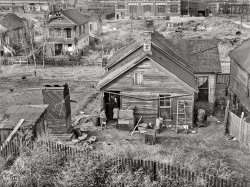
- Soldiers Joy: 1940
- ... between the raindrops on their way to the entrance.
John Vachon would head there eventually This same month, John Vachon was in ... Posted by Dave - 08/05/2020 - 2:23pm -
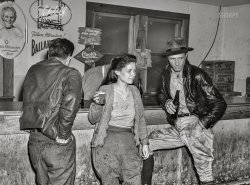
- Fender, Roads: 1942
- ... Bannack, Montana's first capital." Acetate negative by John Vachon for the Office of War Information. View full size.
Geez -- At ... Posted by Dave - 10/20/2021 - 3:29pm -
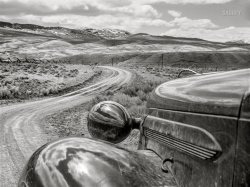
- Pails in Comparison: 1939
- ... Wisconsin schoolhouse. View full size. Photograph by John Vachon.
Advertising Opportunity Lost No cartoon characters on those ... Posted by Dave - 12/11/2007 - 9:43pm -
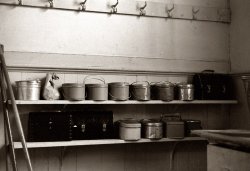
- War News: 1942
- ... son-in-law, Mr. and Mrs. Len Smith." Acetate negative by John Vachon for the Office of War Information. View full size.
Month by ... Posted by Dave - 10/19/2021 - 11:12am -
![War News: 1942 April 1942. "Wisdom, Montana. The Ansons visit their daughter and son-in-law, Mr. and Mrs. Len Smith." Acetate negative by John Vachon for the Office of War Information. View full size.
Month by Month With VachonBased on the last several posts, John Vachon apparently spent the winter and spring of 1942 touring the upper Midwest, sending back windswept snow scenes so chilling I shivered, and social suffocation scenes like this one that make me want to go out and walk down to the local tavern to escape. Coupled with the coy, on-the-road self portraits you've shown us before, I'm starting to regard him as a mythical, Everyman sort of character straight out of Kerouac. Can't wait to see where he's headed next.
Doolittle Raid, James Doolittle and co-pilot Richard Cole"War Information" in action. The headline has it: this was the Doolittle Raid of April 18, 1942, the first U.S. air strike on Japan. The low-level daylight attack killed 50, injured about 400, and did minimal physical damage; but the psychological effect was great on both sides--witness that headline.
The last survivor of the crew, co-pilot Richard E. Cole, died at 103 on April 9, 2019. In the photo below, pilot Lt. Col. James Doolittle is second, Lt. Cole fourth from left.
Sassy lookin'Ceramic cat.
I sense tension in the roomMr. Anson is unhappy about something, and is searching for just the right words to convey his thoughts to Mr. Smith. Meanwhile, Mr. Smith is pretending to be absorbed in his magazine as he awaits the complaint.
Doolittle RaidI'll get my comment in before the rush - I'm sure most Shorpy faithful know who and how Tokyo was bombed a mere four months after the war started. Pretty much the first bright spot for the US in WWII to offset the litany of setbacks, retreats and surrenders.
Couldn't Mom have a chair?Instead of making her sit on a tuffet? Even a kitchen chair would have been more comfortable. And she's still wearing an apron from doing the dishes!
[That's not Mom. - Dave]
I wouldn't call it "news"The Time magazine issue Mr. Smith is reading is dated March 9, 1942.
[I wouldn't call it Time, either. - Dave]
Questionable framingMr Vachon probably regretted capturing so much of the top of the room at the expense of the lower parts where the people live. I'm curious what that blurry thing is in the right foreground -- thought for a while it might be an accordion, which would certainly liven things up. These people don't appear to be the big smokers that so many folks in Shorpy pix are -- there's maybe an ashtray on the desk, but it looks like it's used for something else.
Life MagazineThe issue is dated March 9, 1942
Let there be LightMust be a dark room. Five lamps! And that's just one corner of the room. Near the windows.
Strategic Outcome of the RaidIt was the Doolittle Raid that convinced the Japanese military leadership to increase their Pacific defensive zone - hence the attack on Midway Island in June of 1942. That disaster was the turning point in the Pacific war and marked the outward boundary of the Japanese conquests in WWII.
What is that apparatus?Is that an accordion or an organ in the lower right?
A surfeitof lamps!
Family of readers.On the far right, we see glimpses of the daughter, who appears to be going through the mail. What a bunch of readers they all are. The radio was probably also on. Mom being forced to sit on the tuffet seems harsh though.
[Daughter is in the middle. Mrs. Anson is at far right. - Dave]
The Front Page
Had to do a double take. After looking at the object on the desk and thinking it was some kind of streamline mouse, I finally figured out that it's a blotter. For when you're writing letters at that lovely desk.
Also doesn't look to me as if sis is wearing her apron from doing dishes looks more like she's getting ready to cook dinner because i do believe that is a handwritten recipe book in her lap.
["Sis"? That's Len's wife. - Dave]
My dad often called my sisters quote 'sis'; I even had a cousin Sis.
Blurry heater?The blurry object in the right foreground might be a gas or electric heater, very useful in Montana.
(The Gallery, John Vachon, Small Towns, WW2)](https://www.shorpy.com/files/images/SHORPY-8c21850a.thumbnail.jpg)
- Let's Eat: 1942
- ... instructor, and family at home." Acetate negative by John Collier for the Office of War Information. View full size.
... Or just to have their group portrait taken?
I recall John Vachon's 1940 photo of six construction workers in the parlor of Mrs. ... Posted by Dave - 03/29/2024 - 12:22pm -
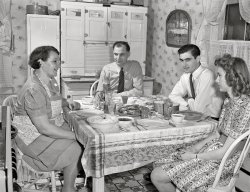
- Dakota Clipper: 1942
- ... Dakota. Barber shop." Medium format acetate negative by John Vachon for the Office of War Information. View full size.
Two Chairs - ... Posted by Dave - 10/25/2021 - 11:43am -
![Dakota Clipper: 1942 February 1942. "Timber Lake, Dewey County, South Dakota. Barber shop." Medium format acetate negative by John Vachon for the Office of War Information. View full size.
Two Chairs - No WaitingI'm guessing that the second chair didn't get much use. Timber Lake had a population of 512 in 1940. If half of those (256) were men, I figure that's about enough to keep one barber employed. Or two barbers in poverty.
PerfectedIt's interesting how few of the implements around that shop would be out of place today. Step into that barber shop today you'd maybe just see an added hair dryer. It's like the barber shop reached perfection about 100 years ago and can't be improved upon! Few other professions seem to have changed so little.
Clipper?Is the Dakota Clipper related to the Spruce Goose?
And the barber needs a shave.
The building across the street is a real architectural showpiece!
South Dakota for sure!It wouldn't be South Dakota without the rooster pheasant on the clock! That state is rich in pheasant.
Vachon the virtuosoImpressive how he managed to avoid getting his flash, camera or himself in any of the multitude of reflections possible, what with the mirrors and windows and windows reflected in mirrors.
[The reflections are there in the negative but I got rid of 'em. - Dave]
Good Exposure Inside and OutJohn Vachon certainly knew how to use flash or a large photo-flood. The edges of both the barber and customer are quite hard, which gives me pause. But notice the car in the window, and its reflection in the mirror.
Worth a look:
https://mastersofphotography.blogspot.com/2011/08/john-vachon.html
Not an Alberta Clipper... but cutting it pretty close.
Searching the 1930 and '40 US Census, I find a barber in Timber Lake named Henry Perron. But wait, there's more! His son William is also listed as a barber, and Henry Jr. is listed as an Apprentice at the barber shop. The 1940 Census indicates Henry Jr. has moved to Illinois, but William is still in business with his father.
In 1942, William would have turned 34 years old. As father Henry would have been 67 in '42, it seems likely we see William in this photo.
Henry's parents were born in Canada, and with the surname of Perron, you'd be correct in supposing he's of French Canadian stock. (Henry's page at Find A Grave: https://www.findagrave.com/memorial/121638292/henry-peter-perron )
Below is an edited capture from the 1930 Census.
Surprisingly, there is also a Dane named Arlo L. Jensen Sr. who is listed as a barber in Timber Lake in the 1940 Census. However, he is in his mid-50's in 1942, and our man here appears a bit younger. Apparently many a mane was to be shorn in the Timber Lake demesne!
Saturday Evening Post?I swear this looks just like something done by Norman Rockwell. Especially the expressions on the men's faces.
That's weirdI can smell this photo.
Not just for menThere are some barbers who work on both men's & women's hair. I know, because I go to one. In fact he advertises that on his calendars.
This barbershop had a mascotIn the shadow underneath the window is a small dog and what appears to be a food bowl. Clipper would have been a good name.
[Or maybe Harry. That's a spittoon and a pile of hair. - Dave]
Barber needs a shave?But does he shave himself?
Great Pheasant!Great area for pheasant hunting as noted by the clock bird. I assume this is why Alfalfa's father is getting a trim.
The good life Being a barber in that area and era (or any era) would seem to be a pretty
comfortable life, other then the cuts and nicks in the beginning.
But once you become a competent barber you're always warm & clean.
especially considering the weather beaten guy in the chair is only 40.
'20s styleThe man in the chair who appears to be close to 50 is still wearing his hair in the parted-in-the-middle style of the 1920s!
Pa Kettle, Is that you?The customer is a dead ringer for Percy Kilbride, aka Pa Kettle (although the part down the middle looks more like Alfalfa).
Keep it glassyI'd love to add those old glass bottles to my (small but significant) collection.
(The Gallery, John Vachon, Small Towns)](https://www.shorpy.com/files/images/SHORPY-8c21018a.thumbnail.jpg)
- All Washed Up: 1942
- ... washing up at the end of the day." Acetate negative by John Vachon for the Office of War Information. View full size.
Reinforcing ... Posted by Dave - 01/29/2024 - 12:43pm -
![All Washed Up: 1942 November 1942. "Sunray, Texas. Carbon black plant workers washing up at the end of the day." Acetate negative by John Vachon for the Office of War Information. View full size.
Reinforcing AgentCarbon black is officially my new favorite reinforcing agent in the production of automobile tires in the mid 20th century.
I enjoy a naked man as much as anyoneBut you would think their employer would provide them with showers. Giving them a bucket in a sink is insulting.
[Showers, you say? - Dave]
Thanks, Dave. Those 1942 Sunray boys got some fine physiques. Now, I'm guessing the bucket wash was to get the worst of the carbon black off before hitting the showers. That carbon black must have clogged the drain and the septic tank. The water bucket was most likely dumped on the ground outside.
[Or these photos are from different plants -- Moore County's gas fields made it the center of the carbon black industry. - Dave]
Fit as a FiddleThese guys are in great shape, although I'll bet neither one of them has ever worked out or watched his calories.
WOW!More skin than an X rated movie!
Cellulite?I don't think you can "pinch an inch".
Cover-upUntil I looked at the original image at the Library of Congress, I did not realize the Shorpy version is altered to change an R-rated image to a PG.
If only ...If only they could wash their lungs as easily.
Like black flourIn college in the mid 90s I worked at a Japanese plant that made rubber products. They used huge bags of carbon black. To me, it looked exactly like jet-black flour. Those guys always looked like coal miners.
(The Gallery, Factories, John Vachon)](https://www.shorpy.com/files/images/SHORPY-8d10368a1.thumbnail.jpg)
- Migrant Mother: 1940
- ... roadside camp of cherry pickers." 35mm nitrate negative by John Vachon. View full size.
Vachon I don't like all of John Vachon's ... Posted by Dave - 05/17/2011 - 8:09pm -
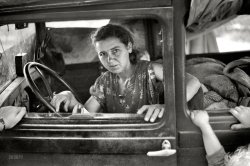
- Sunray: 1942
- ... plant. Sunray, Texas." 4x5 inch Kodachrome transparency by John Vachon for the Office of War Information. View full size.
You might ... Posted by Dave - 01/28/2024 - 2:43pm -
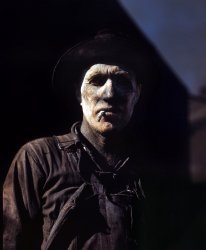
- Times Square: 1943
- ... Square on a rainy day." Medium-format nitrate negative by John Vachon for the Office of War Information. View full size.
Color me gray ... Posted by Dave - 08/01/2012 - 1:35pm -
![Times Square: 1943 New York, March 1943. "Times Square on a rainy day." Medium-format nitrate negative by John Vachon for the Office of War Information. View full size.
Color me grayThis would be fun to see in color: the brightness of the billboards and the taxis would really stand out against the steely cold damp drabness of everything else. Colorizing after the fact wouldn't quite capture the atmosphere, but maybe I'll try anyway. Unless someone else wants to...?
Saludos Amigos en la Plaza del TiempoThe Globe Theater on the right has put up a lavish display for Walt Disney's "Saludos Amigos," a 42-minute feature cartoon that encouraged our wartime "Good Neighbor Policy" with South America. Here's the Disney lobby poster that the Globe copied for its building-high banner.
March 1-17, 1943Well, the only way I can narrow down the date is to find out that the movie at the Globe changed beginning Thursday, March 18 (Saludos Amigos had its last showing on the 17th). Are there any other little hints in the picture to help date it?
Blackout!Check out the blackout headlights on the taxicabs. My mother remembers those.
Taxi!Those taxicabs look particularly strange, kinda like a 1930s front plastered on a 1940-ish body shell. And the coupelet back makes them even stranger! Any idea what they are?
[Circa 1940 Checker Model A. - Dave]
Mother & Father DuffyAt the far left, you can see the Father Duffy Statue. Here's the statue in 1944. The pretty woman in the middle is my mother.
BeerSchaefer is the one beer to have...when you're having more than one!
Now you know the rest of the jingleSchaefer is the one beer to have...when you're having more than one!
Schaefer's pleasure doesn't fade even when your thirst is done.
The most rewarding flavor in this man's world, for people who are having fun.
Schaefer is the one beer to have when you're having more than one.
I wonder how long it's been since that was on the airwaves...
Stop n GoIs that one of the old-fashioned stoplights that only had red and green lenses? I would have thought those were all gone by 1943.
BroadwayThis picture shows Seventh Avenue, which looks like it was a two way street then. Out of the photo, to the left, would be Broadway. Mayor Bloomberg has shut off any traffic between 47th and 42nd Streets on Broadway. It is now a mall, complete with folding chairs and is mobbed on the nicer days.
GloomyIt makes me shiver just to see this photo. How gray and cold that rain must be. I also notice the "Buy War Bonds" sign on the Flatiron Building, and the WAAC sign. Is that a recruiting station or something? Also visible above the marquee is an Orpheum sign, presumably from the old Vaudeville days. A real step back into America's past. I wonder if it was Sunday, with so few people on the street.
[That's not the Flatiron Building. Which is taller, and not on Times Square. - Dave]
Laffmovie Here, a 5/15/43 NY Times entry about the theater to the right of the Astor.
http://query.nytimes.com/gst/fullpage.html?res=9802EFDD103CE03ABC4D52DFB...
Parts of the 42nd Street sister-theater mentioned in the article have been put to good use as the AMC Empire 25.
http://cinematreasures.org/theater/255/
Depression That brilliant facade of the night, the signs that scream see this, drink this, buy this, are stripped of their promise by the harsh drab light of day. Across the street is the Orpheum. A gilded palace where baggy pant top bananas tell stale jokes and cheap B girls shimmy and strip to the cat calls and wolf whistles of the lonely and desperate. I pull up my collar against the wind and start across. My feet make pearlescent rings in the oil drenched street. It's a cold rain, but not enough rain to wash the dirt from this city. Depression is daylight, and rain and Times Square.
Crossed StreetsPerhaps Mr. Mel has Bway and Seventh reversed. In the foreground Broadway is on the right -- a two-way avenue at the time, one-way going south when I moved here, no-way as of last month (pedestrians only). Seventh Avenue is out of view on our left. In the distance where the Times building is (with a V for "Victory" and War Bonds), the two cross and Broadway goes away down the canyon to the left and Seventh Avenue continues down the canyon to the right.
WAAC = Women's Army Auxiliary Corps, soon changed to Women's Army Corps (the famous WACs of the WACs, WAVEs, WASPs, and SPARs).
Re the Flatiron Building misidentifications, I myself got the Times tower confused with yet a third building in the Central 40s (still standing) in another Shorpy last week. It's too easy to get confused because with the ugly sheathing obscuring all the turn- of- the- century beauty, the Times tower shell we see today isn't recognizable to its appearance in photos.
This is wartime and the neon signage is a sad subdued shadow of its peacetime glories.
Admiral -- Canadian ClubNot only is that not the Flatiron, it's the building Times Square was named after -- the old New York Times headquarters. Known mainly for the past 60-odd years as the building that holds up the big billboards at the end of Times Square. It's encased almost entirely in signage.
Now that's Times Square!Mysterious and alluring, rain or shine, night or day. Not the sterile, Disneyfied pedestrian mall that's closed off to traffic now.
Red and GreenI'm not sure when New York replaced all the older two-color lights, but I can remember them still being around during my childhood in the mid- to late-1950's. As I recall, at one point they had them showing both red and green to mean "caution" in place of the yellow light.
Some things never changeThe manhole covers look the same today. The potholes, too.
Taxi grabThat shot of the Checker Model A taxi is a frame grab from the film Kiss of Death (1949). The one where Richard Widmark pushes the old lady in a wheelchair down the stairs.
Trash basketsI love the wire trash cans. They're right out of a Looney Toons reel. Do these still exist?
47th StreetThis is looking south from 47th Street. The building on the right has been replaced by the W Hotel and the Marriott has replaced the building just south of that. This is where the TKTS booth is nowadays.
And as a matter of fact, my office window (where I am sitting right now) is on the left -- just to the right of the letter A in "State".
MasterpieceAlso visible is a billboard for "The Human Comedy," a superb movie, a bit maudlin now, but still a classic and well worth watching.
Admiral-Canadian Club ReduxThat Admiral - Canadian Club stack of signs was at the north end of Times Square and not hung on the Times Tower on the south end. Notice that the Astor Hotel is on the left, or west, side of the Square. The Astor Theater was a favorite with my family, when we were in town just to see a movie, and not to go to the Paramount, Roxy or the Music Hall (or to the Center Theater for the ice show), all of which complemented their movies with stage musical and comedy shows, such as The Phil Spitalny All-Girl Orchestra featuring Evelyn and Her Magic Violin, Phil Silvers, and Danny Kaye. Wow! There were giants (managed by Bill Terry and Mel Ott) in NYC in Those Days!
And weren't those funny-looking cabs DeSotos?
[The ones in this photo are Checkers. - Dave]
Movie schedule"The Human Comedy" opened at the Astor Tuesday, March 2 so that eliminates one day.
The Lonely CrowdI love the complete anonymity of the few people in this photo. You can't see their faces. They could be anyone, lost somewhere in the sprawling metropolis.
Horn and HardartThe building just to the right of the Globe Theater (partially shown) is Horn and Hardart Automat. If this is 1943 it may not have been the Automat yet, as I didn't get to New York until 1947, at age 15, but by then it certainly was the Automat as I was in it a lot. Coming from Boston and all alone I was a scared kid to be in middle of Times Square. The Palace theater was across the street showing "The Spiral Staircase." I believe to the right of the Astor was the Victoria Theater, probably yet to be where the Laff Movie seems to be in 1943. I think the Globe was later to be the Times Square Theater or something like that. I remember seeing "An American in Paris" there around 1953.
Times bldg. & Flatiron bldg.Sorry, Dave, but according to emporis.com Times is taller than Flatiron (110.64 m vs. 86.87 m).
Funny thing is that I too misidentificated these two buildings before I started read more about Manhattan skyscrapers. Now I'm old NYC highrise fan and I love your site.
[Maybe you're still a bit confused. The Times building is behind the "Buy War Bonds" building, which is just 16 stories tall. - Dave]
The 1943 Father Duffy area in 2009As of 2009, the large Celtic looking stone cross to the left in the 1943 pic is now directly at the bottom of the steps of the TKTS booth in Times Square.
The other side of the cross has the statue of Father Duffy so the 1943 pic is facing south. I think that spot is still called, Duffy Square? Interesting how the subway entrance used to be in what is now pavement in the middle of the two streets.
Here's an example to compare it to. "Times Square: 1943"
http://www.nytix.com/repository/broadway/TKTS/times-square-steps1.gif
And the ladies under the Father Duffy pic in 1944. "Mother & Father Duffy"
http://gothamist.com/attachments/jen/2008_10_tkt18.jpg
+66Here is the view from the identical location and angle from August of 2009. As Azelzion noted, the Horn and Hardart Automat is visible on the right of the original photo (my father told me that the one time he visited New York City was when he was in the Marines in the early 1950's and had Thanksgiving dinner at that automat). The Grand Slam souvenir shop now occupies that site. I believe it is the same structure but under a new facade (no traces of the automat can be seen inside, either). The Globe Theater, which also has an "Orpheum" sign, next door to the automat was replaced by a Howard Johnson's restaurant in 1955 and was a Times Square landmark until it closed in July of 2005 (I was fortunate to have had lunch in the aged but still charming restaurant in November of 2004). The site is currently undergoing construction of a new building to house a retail store.
WAAC BoothHere's a closer view of the WAAC booth with my Mom and her friends. Taken the same day as the pic below with Father Duffy.
Locus of creativityThis wonderful image adds another dimension to the descriptive work from that era left to us by Kerouac; it is the Times Square of Edie Parker, Huncke, Lucien Carr, Burroughs, Ginsberg, and late-night camaraderies that inspired some of the best writing of that generation.
Almost exact location, 11 years laterAbout 11 years later, my grandfather took a picture on a very similar, rainy day. He was about half a block farther south, and little bit to the left.
One thing that surprises me is that the first movie theater just south of 46th has a Planters ad over the marquee, and not an ad for what's showing, like in the 1954 image. Other little changes, like light poles are different, no WAAC globe in 54, and many more pigeons!
In Living ColorA large full colorized version can be found here.
More on the Checker Model A here.
About that traffic lightA couple commenters noticed the traffic light with only red and green; New York City didn't start using red-amber-green until the early 50's, and the transition took about 40 years to complete. I remember seeing some red-green signals still hanging on here and there in the city through the 70s.
The other interesting thing about this particular light is that you can see here that the lenses are masked for war-time darkening. There is only a very small cross of light visible for each indication, rather than the whole 8"-wide ball that would normally be visible. I find it amazing that anyone could see these signals darkened like that.
(The Gallery, Cars, Trucks, Buses, John Vachon, NYC)](https://www.shorpy.com/files/images/8d26849u.thumbnail.jpg)
- Unpacked: 1939
- ... your stay in the Edward Hopper Suite. Acetate negative by John Vachon. View full size.
Vachon knew what he was doing Must be ... Posted by Dave - 10/24/2019 - 11:56am -
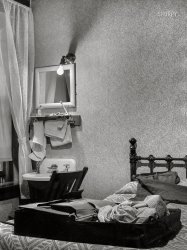
- Grand Hotels: 1942
- ... on West Grand Avenue." Medium format acetate negative by John Vachon for the Office of War Information. View full size.
Urban ... Posted by Dave - 01/15/2024 - 12:00pm -
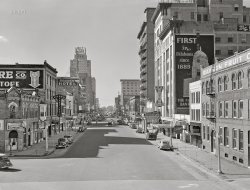
- Dark Matter: 1942
- ... a carbon black plant." Medium format acetate negative by John Vachon for the Office of War Information. View full size.
The Eyes Have ... Posted by Dave - 01/28/2024 - 3:02pm -
